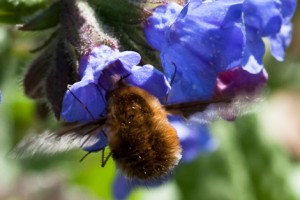Those of you who know me realise that I have developed a bit of an obsession with photographing bees. This is mainly because they are there, but I am also developing a bit of an interest in them.
My macro photography improved tremendously last year as I photographed any insect I could find in the garden (it also had the advantage that I didn’t have to travel more than a few metres). However, Winter came long with the absence of insects. Now, the sun is shining and the bees are back and after my enforced hiatus I spent a happy few hours last weekend trying to capture bees on my digital camera.
 It is only when you start looking that you see the diversity that is around you. Whilst watching the bees my attention was caught by this little chap – a funny shape for a bee if ever I saw one. I thought I would look on the Open University’s I-Spot website. This is a fantastic resource where you can upload photos or write descriptions of nature which you need help identifying or which you would just like a second opinion about.
It is only when you start looking that you see the diversity that is around you. Whilst watching the bees my attention was caught by this little chap – a funny shape for a bee if ever I saw one. I thought I would look on the Open University’s I-Spot website. This is a fantastic resource where you can upload photos or write descriptions of nature which you need help identifying or which you would just like a second opinion about.
Fortunately there was another picture of my insect on the front page, and, it is not a bee, it is a bee-fly, Bombylius Major being the largest and most common, and corresponding to my friend. It is, as noted, much chunkier than a bee with spindly legs, but is as furry as a bee, and hovers around flowers in a similar way to hoverflies (primoses being one of its favourites) with its proboscis out probing for nectar.
The larvae of a bee-fly are not at all nice though, they live in the nests of solitary bees living off the food stores and grubs of the bees. Although they are quite common at this time of year, this is the first I have ever seen.